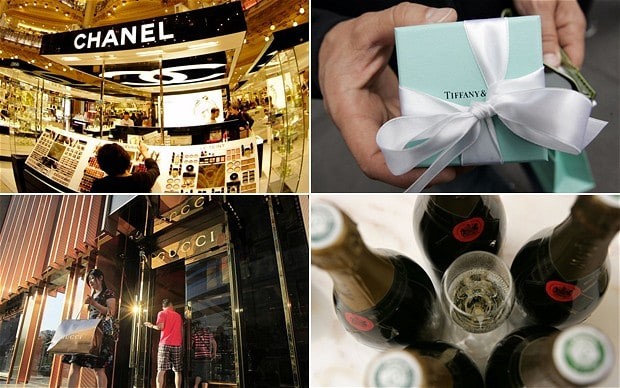Luxury is value-laden in India
Luxury as a concept is not unfamiliar to India. Our culture is unique, Indians have historically never seen a contrast between spirituality and materialism. The dominant Indian culture lays out the rules for the universe, in which preservation always goes hand in hand with wealth and prosperity; Lord Vishnu the preserver is intertwined with Goddess Lakshmi, the Goddess of wealth. The luxury market in India has been growing at a CAGR of 25 per cent over the last couple of years. As per a report published jointly by CII and IMRB based on a survey conducted in the luxury goods market in India the report titled “The Changing Face of Luxury in India” this segment is not as dormant as it was pictured earlier. Since the last 3 years it is estimated to have reached USD 7.58 billion. An ASSOCHAM report says the market is hoped to cross $18.3 billion by end of 2016. It is the luxury categories like apparel & accessories, perfumes, fine dining and automotive that has contributed to this growth.
Another fact about Indian market is, luxury market accounts for almost a negligible 1 – 2% proportion of the global luxury market. Industry experts believe that multiple factors are contributing to the slow growth: low priority status assigned to luxuries by the government, lack of adequate range of luxury goods and service levels that are below par. They also believe that our culture discourages us from flaunting our wealth. Yet luxury goods marketers are optimistic about the above factors changing in the coming years and predict that the luxury market will boom in India over the next few years. Frugality is there in deep psyche of Indians.
According to the Goldman Sachs research report ‘The Asian Consumer,’ India’s urban mass will trade up into brands that offers the most incremental value, but may not readily jump to aspirational brands. However, the report further states that the growth of luxury and high-end, in general, will be limited. Culturally, India’s affluent consumers tend to shy away from ostentatious display of wealth.
Significant brands across various verticals that performed well in 2015 included GUCCI, Christian Dior, Louis Vuitton, Canali India, LVMH India, Judith Leiber, TheSPA Group, Starwood Asia Pacific Hotels & Resorts, and Reliance Brands. Increasing brand awareness and growing purchasing power of the upper class in tier II and III cities is fuelling further growth. Service areas such as fine dining, electronics, luxury travel, luxury personal care and jewellery saw increasing revenues and are expected to grow by 30-35% over the next three years. Spending on luxury cars continue to rise growing upwards at 18-20% over the next three years. As the purchasing power of women is rising in India, the luxury beauty products market is witnessing a fast paced growth.
The past 2 decades of economic growth have seen a substantial new class of wealthy consumers who have joined the ranks of the traditionally rich – from new generation entrepreneurs to senior corporate executives, from farmers who have sold their land off to developers to the BPO generation which lives at home with the parents and has money to splurge. Despite their newfound riches, however, findings indicate that there is an inherent mindset that is ‘middle class’ in India, even among those who can no longer be classified as middle class basis their income. The inner conflict between a middle class mindset and the globally rich income level, between conspicuous consumption and a level of luxury which is a reward for hard work shapes what we call the closet consumer. Closet consumers are cost conscious and seek ‘value’ even when buying luxury products. And their definitions, symbols of luxury are often in variance with conventional definitions and symbols of luxury.
Based on their current lifestyles, values and needs from luxury, a segmentation framework divides these consumers into four distinct segments – spanning across those who are Connoisseurs, Experientialists, Aesthetes and Flaunters; with specifics on aspects that drive each of these segments. The neo rich class of consumers – educated, well earning, classy consumers is also in a rush to buy and consumer luxury products. Luxury is no longer restricted to the rich and famous. In India’s slow-moving luxury market, brands are trying to tap into the deep vaults of closet consumers, a variety of people with no exposure to global brands but who technically can’t call themselves middle class by income any longer.
I read a TOI article last year which says that a 24-year-old man from Haryana who walked into the Ferrari showroom in Janpath in the Capital with cash in a sack and a thick Haryanvi accent on his lips. He wanted a car immediately for his dad’s birthday. But, when he was told that he needs to wait for six months after placing an order, since that’s how long a Ferrari takes to be built, he lost interest. A Ferrari executive told TOI on the condition of anonymity.
Luxury auto maker Audi, which is referred to as the “churi-waali gaadi” (bangle-type logo) in rural India, is also aware of the dormant opportunity. “Smaller markets contribute close to 20% of our overall sales in India,” says Audi India head Joe King. “We have opened dealerships in markets like Karnal, Vadodara and Bhubaneshwar, where the luxury marketers are seeing a growing appetite for luxury. The emergence of a more ambitious middle class with increased purchasing power that understands, values and aspires to own a luxury brand, is significantly contributing to the transformation of the luxury landscape in India.
Another fact is also that the Indian luxury industry that is pegged close to Rs 60,000 crores. Market analysts see a sense of uncertainty due to the complex strategies and buyer behavior prevailing among all its stake holders – consumers, luxury brands and policy makers.
When it comes to marketing luxury products in India, consumers have always valued opinions expressed directly to them. Marketers may spend millions of dollars on elaborately conceived advertising campaigns, yet often what really makes up a consumer’s mind is not only simple but also free: a word-of-mouth recommendation from a trusted source. As consumers overwhelmed by product choices tune out the ever-growing barrage of traditional marketing, word of mouth cuts through the noise quickly and effectively. Indeed, the term word of mouth means consumer-to-consumer communication with no economic incentives. The sender may, however, reap social gratification or rewards.
It is the primary factor behind 20 to 50 percent of all purchasing decisions. Its influence is greatest when consumers are buying a product for the first time or when products are relatively expensive, factors that tend to make people conduct more research, seek more opinions, and deliberate longer than they otherwise would. And its influence will probably grow: the digital revolution has amplified and accelerated its reach to the point where word of mouth is no longer an act of intimate, one-on-one communication. Today, it also operates on a one-to-many basis: product reviews are posted online and opinions dispersed through social networks. Some customers even create Web sites or blogs to praise or punish brands.
While traditional advertising such as TV spots and newspaper ads, as well as digital marketing such as sponsored links on Google, can build brand awareness, they increasingly do not resonate with target audiences. This is especially true among the 18-29 demographic, a group that’s notoriously suspicious of advertising and well aware of the proliferation of fake positive (and negative) reviews. While there’s no single formula for word-of-mouth success, it often starts with creating a culture that encourages consumers to in buying decisions. Word-of-mouth referrals stem naturally from an unparalleled customer experience that fosters clients’ identification with a brand.
I think, marketers must understand that Indians are intuitively value-laden and would think twice behind splurging on a Louis Vuitton bag or an Armani suit. While the reality of the luxury market is there, the price points are not there. Indians are not into buying random luxury products and there is no repeat purchase behavior happening either.
















































